Key takeaways:
- Nutrient deficiencies, such as nitrogen, phosphorus, and potassium, directly impact cannabis plant health and yield, requiring tailored nutrient management strategies for different strains.
- Signs of deficiencies include yellowing leaves, stunted growth, and leaf curling, which can guide growers in addressing specific nutrient needs effectively.
- Proactive measures, including high-quality soil, regular feeding schedules, and selecting resilient strains, can help prevent nutrient deficiencies in cannabis cultivation.
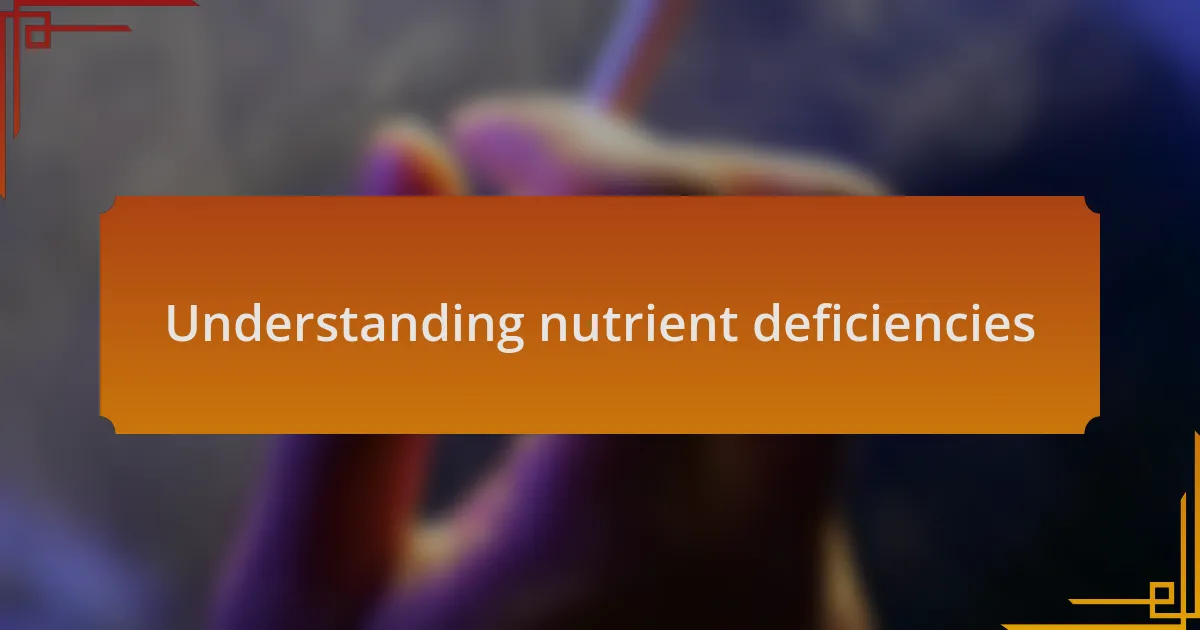
Understanding nutrient deficiencies
Nutrient deficiencies can sneak up on anyone, especially when we’re focused on growing cannabis. I remember a time when my lower leaves turned yellow, and I was baffled. It turned out to be a nitrogen deficiency, which is crucial for healthy plant growth. How could I have overlooked something so vital?
Understanding nutrient deficiencies means recognizing the signs that plants give us. For me, it was the curling of the leaves that really caught my attention, indicating that something was off. Have you ever felt the panic that comes with seeing your plants struggle? It’s a reminder to pay closer attention to their needs.
When addressing nutrient deficiencies, it’s essential to consider the specific needs of your cannabis strain. Some plants respond better to certain nutrients than others. I learned this the hard way after over-fertilizing one strain, which caused more harm than good. It made me realize that a personalized approach is often the key to successful cannabis cultivation. Have you thought about how different strains may require different nutrient management strategies? It’s a fascinating aspect of growing that can truly make or break your yield.
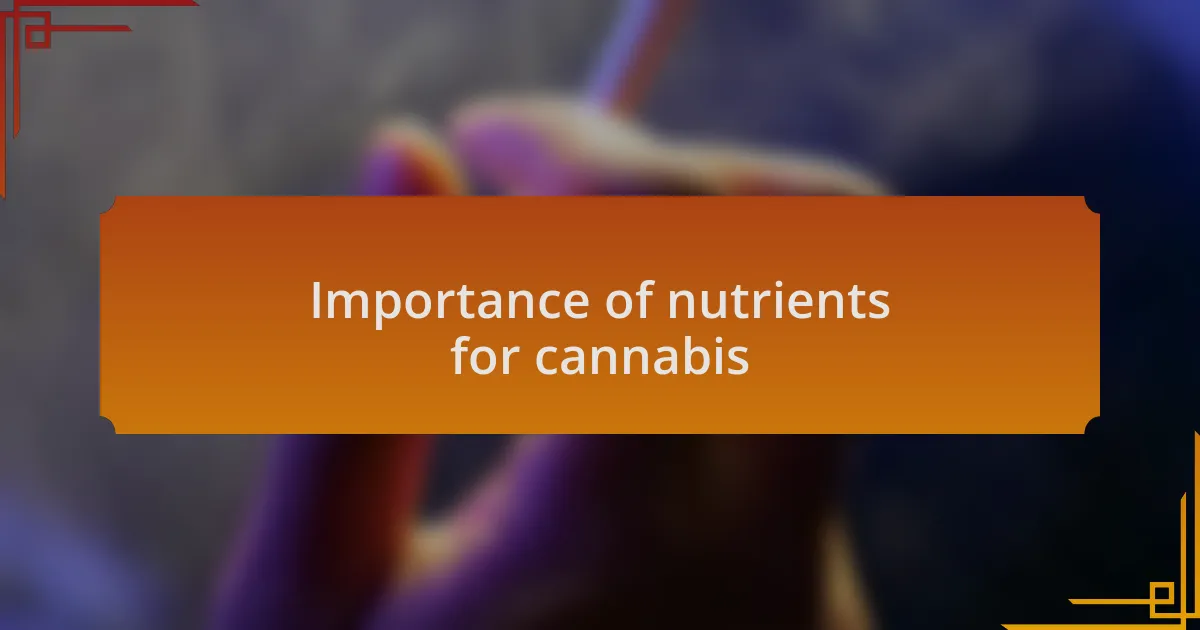
Importance of nutrients for cannabis
Nutrients play a vital role in the health and vitality of cannabis plants. Without the right balance of nitrogen, phosphorus, potassium, and trace minerals, I’ve seen plants struggle to develop properly. There was a time when my plants showed stunted growth because I neglected their phosphorus needs, which is essential for strong root development and flowering. Looking back, it’s incredible how such small elements can have a huge impact on overall growth.
When I think about my nutrient management practices, I remember how impressed I was by the transformation of my plants after correcting deficiencies. I was astonished by how quickly they bounced back after introducing the right nutrients. Have you ever witnessed that thrilling moment of growth transformation? Ensuring that your cannabis plants receive adequate nutrients not only promotes lush foliage but also enhances potency and flavor in the final product.
The importance of nutrients goes beyond just growth; they directly influence the quality of the cannabis produced. I’ve learned that when plants lack essential minerals, the end product can be less aromatic and flavorful. It’s a bittersweet realization to put in all that effort and not achieve peak quality due to something as fundamental as nutrient balance. How often do growers overlook the nutritional aspect thinking the plants will thrive on water and sunlight alone? Being mindful of this balance makes all the difference in creating a harvest you can truly be proud of.
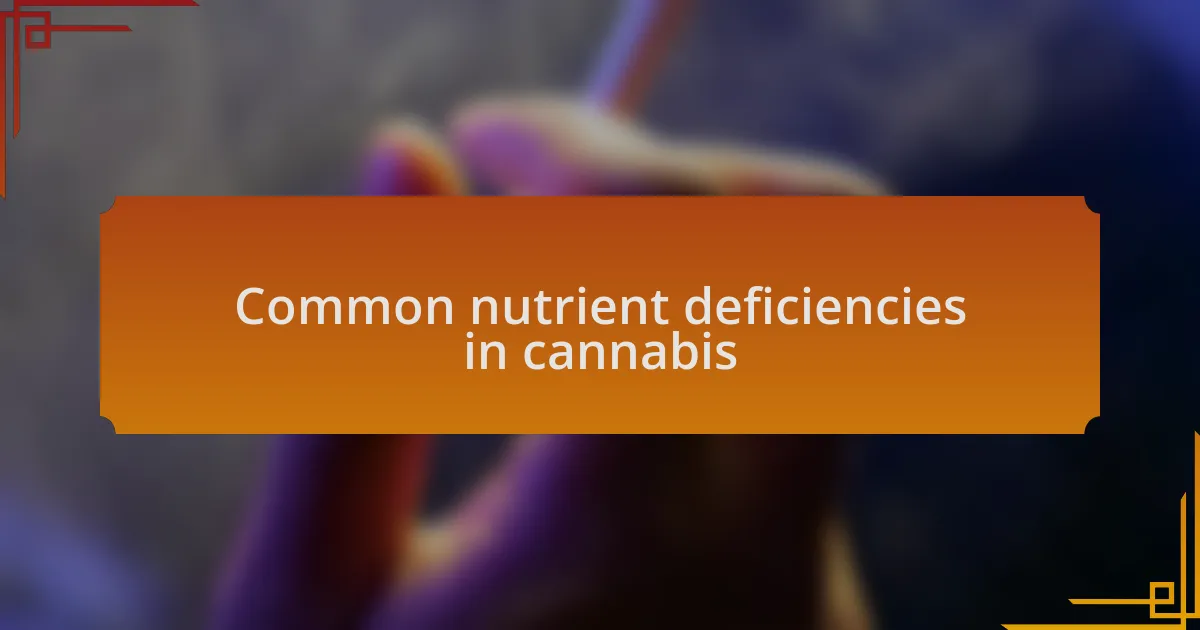
Common nutrient deficiencies in cannabis
It’s interesting to see how common nutrient deficiencies can sneak up on even the most experienced growers. For instance, I’ve had moments where my plants exhibited yellowing leaves, only to realize they were suffering from a nitrogen deficiency. This critical nutrient is essential for healthy foliage and overall growth. When I finally addressed it, the plants responded almost instantly, showcasing a vibrant green that reminded me why I fell in love with cannabis cultivation in the first place.
Phosphorus deficiency is another culprit that can seriously impact your plants’ health. I remember the panic I felt when I noticed poor flowering in my cannabis plants one season. After diving into the issue, I discovered that insufficient phosphorus was to blame, stunting their growth during the crucial blooming phase. Once I adjusted their feeding to include this vital nutrient, the shift was remarkable—the buds became denser and more robust, and I couldn’t help but feel proud of the outcome.
Then there’s potassium. I’ve seen this nutrient often overlooked, yet it plays a pivotal role in regulating water uptake and enzymatic functions in plants. After experiencing a potassium deficiency, which manifested as crispy leaf tips, I made it a priority to monitor the levels in my soil. The difference was noticeable; my plants not only thrived but also exhibited better resistance to diseases. Have you ever felt that exhilarating moment when your plants go from struggling to flourishing just by addressing a single nutrient? It’s a reminder of how essential these elements are in crafting an exceptional cannabis experience.
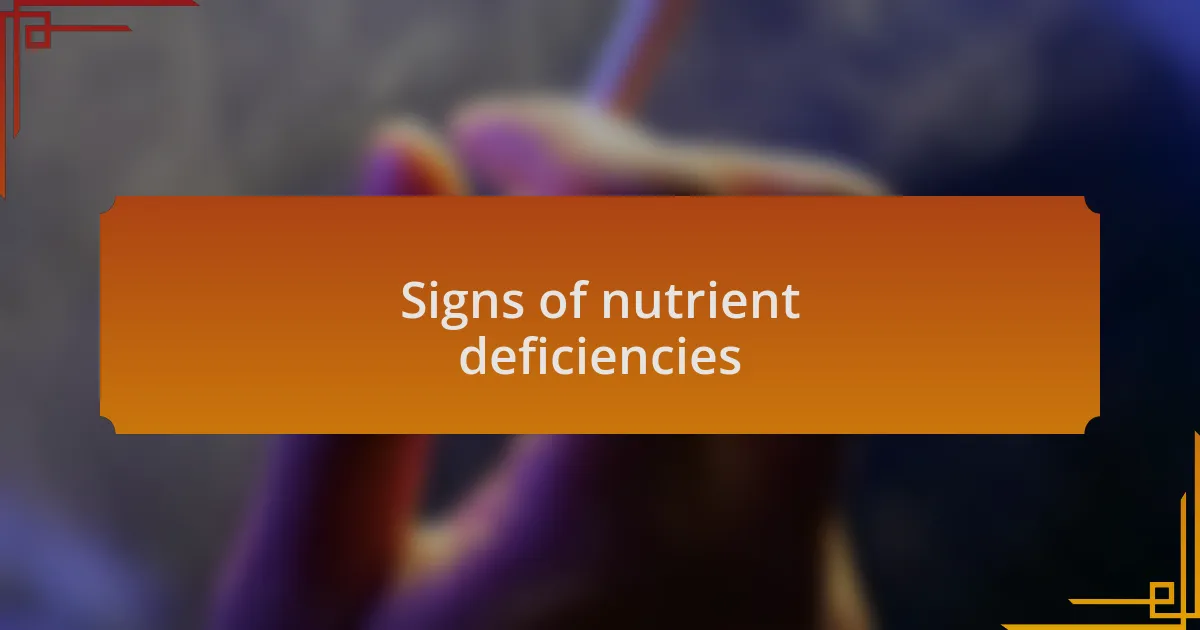
Signs of nutrient deficiencies
When it comes to spotting nutrient deficiencies, I’ve learned that each symptom tells its own story. For example, when I first encountered magnesium deficiency, it presented itself through interveinal chlorosis—yellowing between the leaf veins. I vividly remember the disappointment I felt, thinking my plants were doomed. Yet, after a simple adjustment to include Epsom salt, I watched in awe as those leaves regained their lush, green color. Have you ever seen that immediate transformation? It’s like bringing life back to your plants.
Another common sign to watch for is stunted growth, often linked to missing micronutrients. I recall a time when my cannabis plants appeared to hit a growth wall, barely stretching beyond their pots. After some research, I started incorporating trace elements like zinc and iron into my feeding regimen. The result? A breakthrough. The plants took off! It’s amazing how those small adjustments can spark such significant results, isn’t it?
Then, let’s not ignore leaf curling or wilting, which often signal a potassium or calcium deficiency. I experienced this firsthand one year. I was confused to see some leaves curling under and becoming fragile. After some troubleshooting, I realized I overlooked proper nutrient balance. By now incorporating a more comprehensive feeding schedule, my plants perked right back up. It’s remarkable how these signs can lead you directly to the needed solution, making every observation an opportunity for growth.

My personal experience with deficiencies
Nutrient deficiencies hit hard, and I remember the sinking feeling that washed over me when I spotted purple streaks creeping along the leaves of one of my plants—indicating a phosphorus deficiency. It was like watching my plant’s vitality fade before my eyes. I tried to stay calm, but I couldn’t shake the worry that I had pushed things too far. After doing some research, I started adding bone meal to my soil mix, and slowly, I saw those vibrant greens return. It was such a relief that, at one point, I even found myself smiling at the plants like a proud parent.
During another grow, I faced a stubborn nitrogen deficiency, which left my plants looking pale and leggy. I felt a mix of frustration and determination. It’s a helpless sensation when you know something’s off but can’t pinpoint the issue right away. Eventually, I opted for a high-nitrogen fertilizer, and after a few days, the change was undeniable. The recovery was almost miraculous! Have you ever experienced that sense of triumph when you realize you’ve turned things around?
Then there was the battle with iron chlorosis. One of my favorite strains started to show signs of yellowing leaves, and I panicked. Iron deficiency was new to me, and I felt the pressure mounting—would I lose this wonderful plant? Once I introduced a chelated iron supplement, it was as if the plant took a deep breath. Watching it bounce back gave me a sense of connection and accomplishment, reinforcing the idea that understanding plant needs is a pivotal part of being a successful grower. Have you ever had a similar moment where knowledge transformed a dire situation?
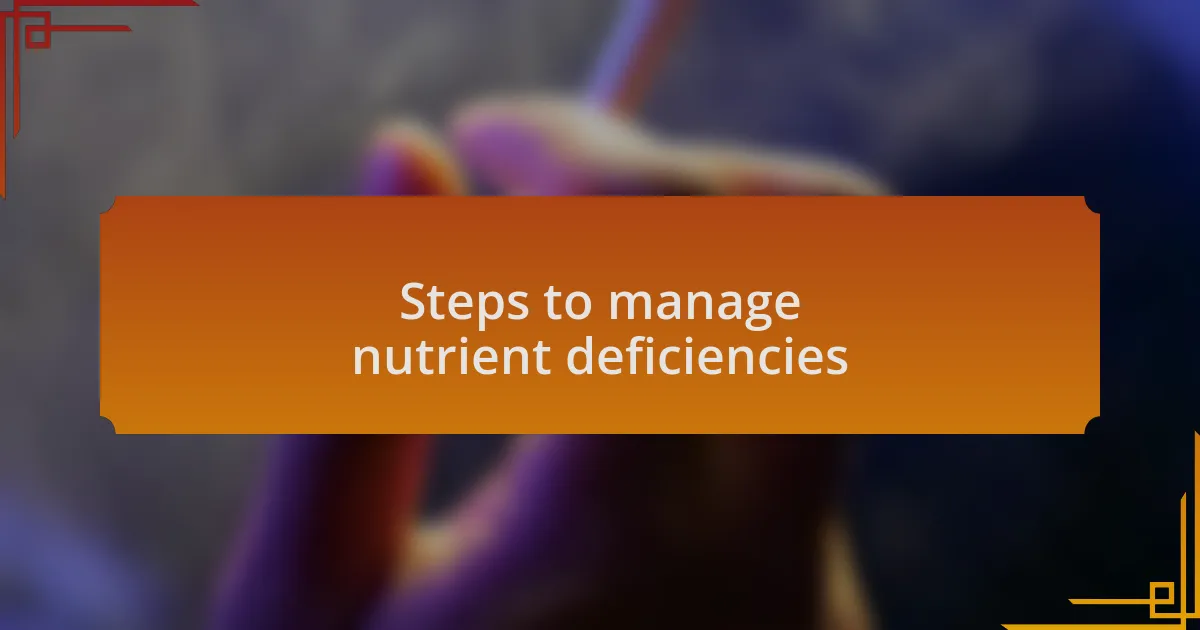
Steps to manage nutrient deficiencies
When managing nutrient deficiencies, the first step is a thorough assessment of your plant’s symptoms. I remember facing a magnesium deficiency, characterized by the telltale yellowing between the veins of the leaves. It was a sobering realization, and I felt urgency to act. By conducting tests on my soil and adjusting the pH, I found that the magnesium level was off balance, which allowed me to tailor my approach effectively. Have you ever taken a moment to really observe your plants, knowing that small details can lead you to a solution?
Once you identify the deficiency, sourcing the right nutrients is crucial. After realizing I needed calcium for my grow, I tried several options, but adding crushed eggshells turned out to be a game changer. I felt a sense of excitement watching my plants gradually improve, and it reminded me how nature can often provide us with simple, yet effective solutions. Have you explored organic options that are easily available in your kitchen?
Regular monitoring and adjustments are key to successful growth. I found myself checking on my plants more frequently, observing changes, and recalibrating my feedings based on their needs. This proactive stance not only enhanced my plants’ health but also deepened my connection and commitment to them. How do you ensure you stay ahead of nutrient management in your own growing journey?
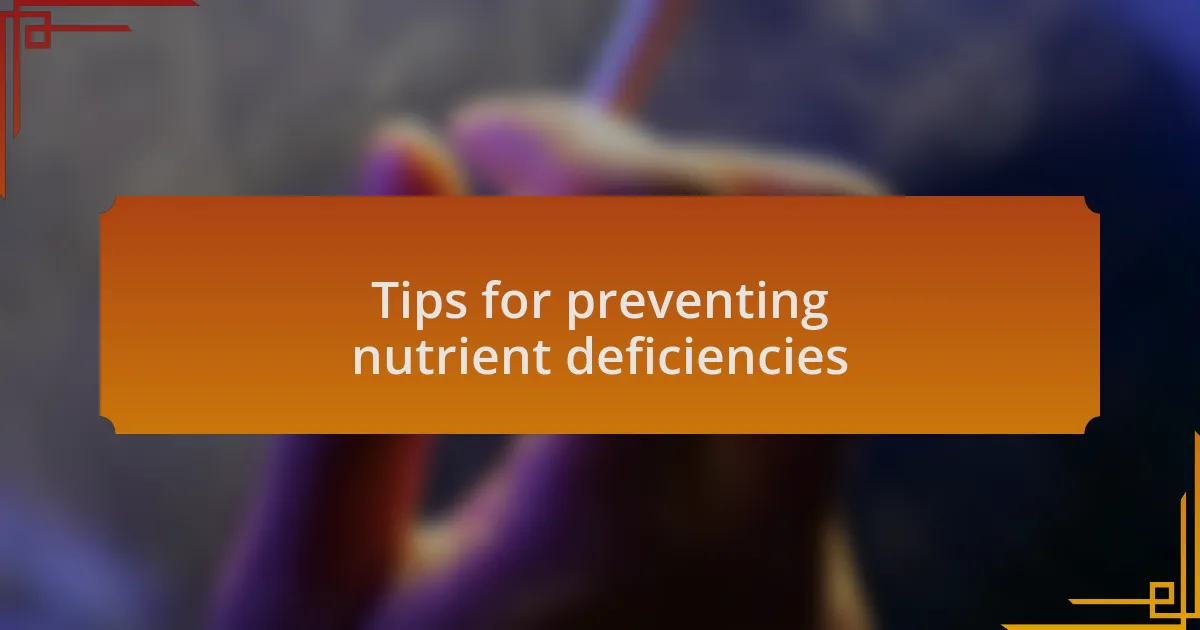
Tips for preventing nutrient deficiencies
Being proactive is one of the best ways to prevent nutrient deficiencies in your cannabis plants. I’ve learned that starting with high-quality soil makes a significant difference. When I switched to a nutrient-rich mix, I noticed that my plants thrived more than ever. Have you ever considered that the foundation of your growth might be a simple change in your potting medium?
Regular feeding schedules can also play a pivotal role. In my experience, establishing a routine for fertilizer applications helped me maintain a balanced nutrient supply. Initially, I was hesitant to adhere to a fixed schedule, but once I committed to it, the consistency provided my plants with the essential nutrients they needed. Are you keeping track of your feeding routine?
Lastly, don’t underestimate the power of good genetics. Selecting seeds known for their resilience and higher nutrient efficiency has transformed my growing experience. There was a time I faced constant nutrient issues until I decided to research and choose strains with a reputation for thriving in diverse conditions. Have you explored different options, keeping in mind how your plants’ genetics can affect their nutrient needs?